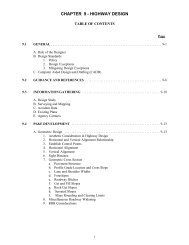Baltimore-Washington Parkway Widening Feasibility Study
Baltimore-Washington Parkway Widening Feasibility Study
Baltimore-Washington Parkway Widening Feasibility Study
- No tags were found...
Create successful ePaper yourself
Turn your PDF publications into a flip-book with our unique Google optimized e-Paper software.
<strong>Baltimore</strong>-<strong>Washington</strong> <strong>Parkway</strong> <strong>Widening</strong> <strong>Feasibility</strong> <strong>Study</strong>Environmental Effects7.0EnvironmentalEffectsThe following presents the results of an initial, multidisciplinary environmental analysis for each of thewidening options, including the No-Build scenario for the B-W <strong>Parkway</strong> corridor. The environmentalanalysis does not constitute a formal environmental evaluation according to NEPA, since there is noproposed Federal action at this time. This analysis, however, is a basic examination of the social,economic, environmental, historic, and cultural resources in the study area and the potential impacts onthese resources that would be anticipated with implementation of each of the proposed wideningoptions.7.1EnvironmentalResourcesThe following describes the environmental resources in the B-W <strong>Parkway</strong> study area. Potentialenvironmental justice impacts are described, followed by a discussion of air quality and noise data.Distinctive habitats and the animals that reside in these areas are noted in this section. Readily availabledata regarding floodplains and wetlands along the B-W <strong>Parkway</strong> corridor is also noted.7.1.2LandUsesThe defined general study area is large, covering about 247-square miles. Land uses in the study areainclude a mixture of residential, commercial, and institutional areas. Alternatives were identified inconsideration of these locations with the intent of providing access to them as well as avoiding orminimizing impacts to them. A summary of land uses within the general study area includes thefollowing:Residential areas are located south of MD 193 in the communities of Greenbelt, Cheverly, andEast Riverdale. North of MD 193 there are clusters of residential areas located near theinterchanges of MD 197, MD 198 and MD 175 in the communities of Laurel, Maryland City, andFort Meade.The study area also includes a diverse mix of large Federal and State-owned properties.Included are the USDA/BARC, the U.S. Fish and Wildlife Service’s Patuxent Research Refuge, theNASA Goddard Space Flight Center, Fort George G. Meade, and the headquarters of the NSA.State-owned properties include two universities, the University of Maryland at College Park,Bowie State University, and the Jessup Correctional Institution.Development proposals and locally identified activity centers in the study area include<strong>Baltimore</strong>/<strong>Washington</strong> International Thurgood Marshall Airport (BWI Airport), Arundel Mills,Odenton Town Center, Greenbelt Station Town Center, and several development projects inCollege Park.60 November 2012
















